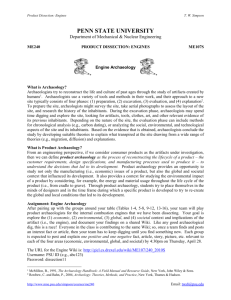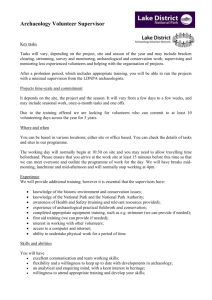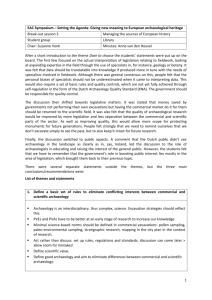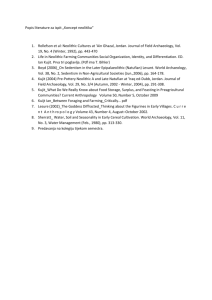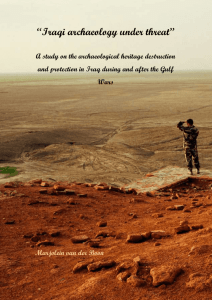Anne P. Underhill - Saving Antiquities for Everyone
advertisement
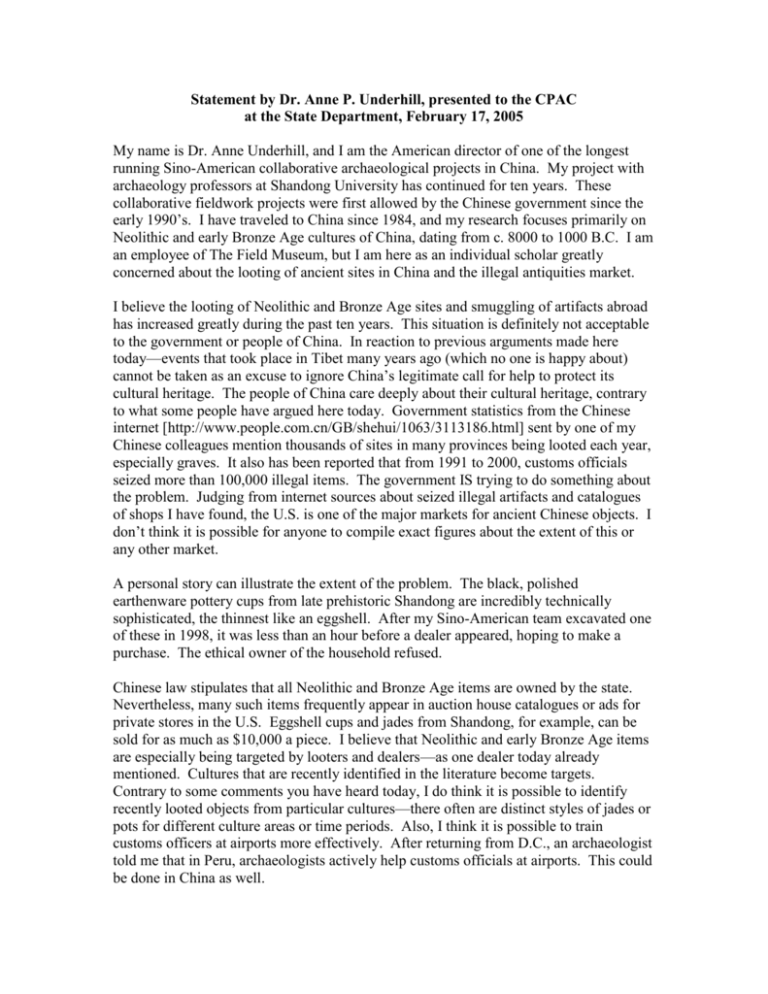
Statement by Dr. Anne P. Underhill, presented to the CPAC at the State Department, February 17, 2005 My name is Dr. Anne Underhill, and I am the American director of one of the longest running Sino-American collaborative archaeological projects in China. My project with archaeology professors at Shandong University has continued for ten years. These collaborative fieldwork projects were first allowed by the Chinese government since the early 1990’s. I have traveled to China since 1984, and my research focuses primarily on Neolithic and early Bronze Age cultures of China, dating from c. 8000 to 1000 B.C. I am an employee of The Field Museum, but I am here as an individual scholar greatly concerned about the looting of ancient sites in China and the illegal antiquities market. I believe the looting of Neolithic and Bronze Age sites and smuggling of artifacts abroad has increased greatly during the past ten years. This situation is definitely not acceptable to the government or people of China. In reaction to previous arguments made here today—events that took place in Tibet many years ago (which no one is happy about) cannot be taken as an excuse to ignore China’s legitimate call for help to protect its cultural heritage. The people of China care deeply about their cultural heritage, contrary to what some people have argued here today. Government statistics from the Chinese internet [http://www.people.com.cn/GB/shehui/1063/3113186.html] sent by one of my Chinese colleagues mention thousands of sites in many provinces being looted each year, especially graves. It also has been reported that from 1991 to 2000, customs officials seized more than 100,000 illegal items. The government IS trying to do something about the problem. Judging from internet sources about seized illegal artifacts and catalogues of shops I have found, the U.S. is one of the major markets for ancient Chinese objects. I don’t think it is possible for anyone to compile exact figures about the extent of this or any other market. A personal story can illustrate the extent of the problem. The black, polished earthenware pottery cups from late prehistoric Shandong are incredibly technically sophisticated, the thinnest like an eggshell. After my Sino-American team excavated one of these in 1998, it was less than an hour before a dealer appeared, hoping to make a purchase. The ethical owner of the household refused. Chinese law stipulates that all Neolithic and Bronze Age items are owned by the state. Nevertheless, many such items frequently appear in auction house catalogues or ads for private stores in the U.S. Eggshell cups and jades from Shandong, for example, can be sold for as much as $10,000 a piece. I believe that Neolithic and early Bronze Age items are especially being targeted by looters and dealers—as one dealer today already mentioned. Cultures that are recently identified in the literature become targets. Contrary to some comments you have heard today, I do think it is possible to identify recently looted objects from particular cultures—there often are distinct styles of jades or pots for different culture areas or time periods. Also, I think it is possible to train customs officers at airports more effectively. After returning from D.C., an archaeologist told me that in Peru, archaeologists actively help customs officials at airports. This could be done in China as well. Archaeologists and professional organizations in China have become increasingly alarmed at the problem of looting. Archaeology is a well-established field. Professional archaeologists are working at universities and archaeology institutes all over the country, and there are numerous professional publications each year. For collaborative fieldwork projects there are clear procedures that foreign scholars and their local colleagues must follow. For example, foreign archaeologists such as myself must apply for permission from bureaus of cultural relics and customs to bring objects temporarily out of the country for analysis—even for things like pots sherds and animal bones. No country, including the U.S., is doing an adequate job of protecting archaeological sites from looting and impeding the illegal antiquities market. In the U.S. we also have a terrible problem of looting in areas such as the southwest—again, driven by factors such as rural poverty. The problem in China, as in many other places in the world, stems from the recognition by rural people that selling antiquities is an easy way to earn money. I do not think that the presence of construction projects has much to do with it. Local people know where ancient sites are, from noticeable features in the landscape and from discoveries of items through farming, etc. People are intentionally looting known sites (including tombs) in their areas to acquire artifacts, because they know they can get good prices for them. The international market is a huge factor fueling this activity. I have seen firsthand, from school children to government officials, how proud the Chinese people are of their cultural heritage. There is much public education about archaeology, from presentations in schools by professionals, to newspaper articles, tv shows, and publications. For professionals, archaeology is a personal endeavor—a way to learn about their own personal history. My colleagues have devoted a great deal of time to publishing books for the public and conducting interviews for TV and newspapers (I also have in China), as well as making presentations in schools. There are collaborative excavations in several areas of the country, including Tibet, involving local people. There are many institutes doing rescue archaeology all over the country—for example I met people who work for such a unit in Jinan city, Shandong. Archaeologists from many areas, including several of my colleagues from Shandong and Beijing, have worked hard to conduct rescue excavations in the Three Gorges area during the past four years. In late December 2003 I visited such an excavation in a soon-to-beflooded area of Hubei province. The archaeologists had just finished their work, living in rough conditions with no heat. The argument I heard that “whole civilizations are being destroyed forever by the dam” simply is not true. Many new museums in this area and others, funded by government money, are established each year. According to Roderick Whitfield and Wang Tao, 1999 (Exploring China’s Past. New Discoveries and Studies in Archaeology and Art, Saffron Books, p. 245), the government of China organized a massive survey of the Three Gorges area before construction began, to assess the areas with sites that would be flooded, with the involvement of 18 archaeological institutions. As of 1999, 800 sites were already registered, and no doubt there are many more by now. The Chinese public did not have a choice as to whether this dam was going to be built. It is clear that the archaeological community continues to work hard to excavate as many sites as possible in the area. Publications about excavated sites in the affected areas have been appearing in a wide range of media for the past several years. There are numerous publications, for professionals and the public, that anyone can access about excavations in China. There is an impressive, national newspaper called “Zhongguo Wenwu Bao” (Cultural Relics Newsletter of China) that is published every single week—far more than what most countries (including our own) publish. This newspaper details recent discoveries about archaeology. There also are bilingual Chinese-English books that describe the most important discoveries for each year. Again there is no publication like this in the U.S. Recognition by the U.S. that China has the right to control its own cultural heritage—a right we insist on for ourselves—will pave the way toward more collaborations with China. For one, it would inspire the Chinese government to safeguard more funding for customs officials and cultural management bureaus in many cities. Americans could offer advice on other measures they have found effective to protect our own cultural objects. I agree that the situation regarding the probable easy flow of goods abroad from Hong Kong does not sound acceptable and that we should inquire more about this. By showing support for China’s legitimate request to restrict the importation of at least some ancient items into the U.S., we would give China incentive to more carefully monitor the situation in Hong Kong. We could even make it a requirement of the agreement. Americans currently have more opportunities to access China’s rich past than ever before, from collaborative exhibitions showcasing loaned treasures, such as the Forbidden City exhibition at The Field Museum, to collaborative archaeology projects, to exchanges of students and scholars. Our Forbidden City exhibition involved an unprecedented amount of treasures being loaned to our museum—many of which had never been shown outside of China. I think the argument that supporting China’s request for import restrictions will make it impossible for American museums to acquire artifacts or temporary exhibitions about China makes no sense. In Shandong numerous museum directors have told me about their willingness to loan materials. There is no doubt that blockbuster shows with numerous treasures from ancient China, such as “Ancient Sichuan” in Seattle, 2001, will continue to be possible in the U.S. Showing respect for China will pave the way towards fruitful relationships. By supporting China’s legitimate request for import restrictions and demonstrating we share its concerns about protecting its cultural property, Americans would have a much better chance at expanding collaborations in many other endeavors. A strategy of cooperation and mutual respect is what we need. Our demonstration of concern would encourage China to take more action, including putting more funding into protecting sites at the local level and training customs officials to recognize looted artifacts. It also would inspire other countries like Japan to take similar steps to help stem the flow of illegal antiquities. I think it is essential that we support China’s legitimate request, at least in part. The world needs the United States and China to develop stronger ties and mutual respect, for a wide range of issues. Supporting China’s request for import restrictions is definitely in our national interest.. Thank you.



